人教版 高二英语必修五unit1语法总结(无答案)
- 格式:doc
- 大小:46.50 KB
- 文档页数:5
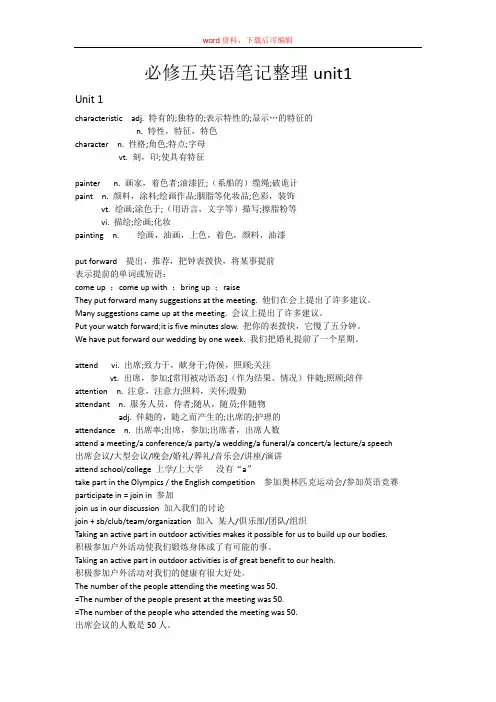
必修五英语笔记整理unit1Unit 1characteristic adj. 特有的;独特的;表示特性的;显示…的特征的n. 特性,特征,特色character n. 性格;角色;特点;字母vt. 刻,印;使具有特征painter n. 画家,着色者;油漆匠;(系船的)缆绳;破诡计paint n. 颜料,涂料;绘画作品;胭脂等化妆品;色彩,装饰vt. 绘画;涂色于;(用语言,文字等)描写;擦脂粉等vi. 描绘;绘画;化妆painting n. 绘画,油画,上色,着色,颜料,油漆put forward 提出,推荐,把钟表拨快,将某事提前表示提前的单词或短语:come up ;come up with ;bring up ;raiseThey put forward many suggestions at the meeting. 他们在会上提出了许多建议。
Many suggestions came up at the meeting. 会议上提出了许多建议。
Put your watch forward;it is five minutes slow. 把你的表拨快,它慢了五分钟。
We have put forward our wedding by one week. 我们把婚礼提前了一个星期。
attend vi. 出席;致力于,献身于;侍候,照顾;关注vt. 出席,参加;[常用被动语态](作为结果、情况)伴随;照顾;陪伴attention n. 注意,注意力;照料,关怀;殷勤attendant n. 服务人员,侍者;随从,随员;伴随物adj. 伴随的,随之而产生的;出席的;护理的attendance n. 出席率;出席,参加;出席者,出席人数attend a meeting/a conference/a party/a wedding/a funeral/a concert/a lecture/a speech 出席会议/大型会议/晚会/婚礼/葬礼/音乐会/讲座/演讲attend school/college 上学/上大学没有“a”take part in the Olympics / the English competition 参加奥林匹克运动会/参加英语竞赛participate in = join in 参加join us in our discussion 加入我们的讨论join + sb/club/team/organization 加入某人/俱乐部/团队/组织Taking an active part in outdoor activities makes it possible for us to build up our bodies. 积极参加户外活动使我们锻炼身体成了有可能的事。
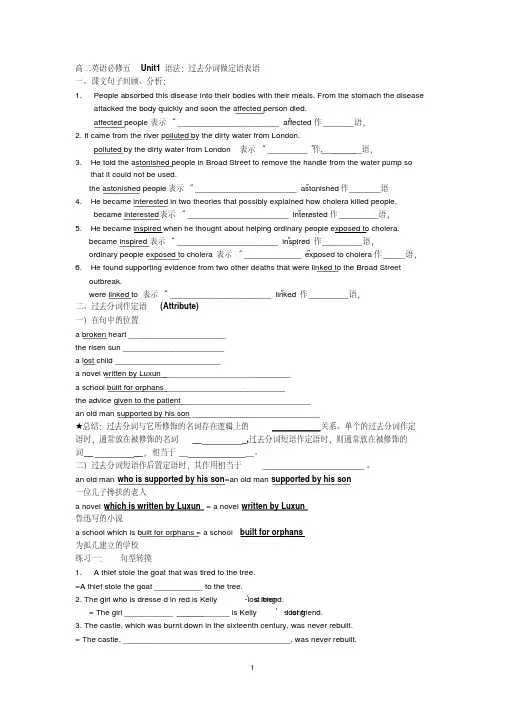
高二英语必修五Unit1语法:过去分词做定语表语一、课文句子回顾、分析:1.People absorbed this disease into their bodies with their meals. From the stomach the diseaseattacked the body quickly and soon the affected person died.affected作_______语,affected people表示“_______________________”,2. It came from the river polluted by the dirty water from London.作__ _语,polluted by the dirty water from London表示“_________”,3.He told the astonished people in Broad Street to remove the handle from the water pump sothat it could not be used.astonished作_______语the astonished people表示“_______________________”,4.He became interested in two theories that possibly explained how cholera killed people.interested作_________语,became interested表示“_______________________”,5.He became inspired when he thought about helping ordinary people exposed to cholera.inspired作_________语,became inspired表示“_______________________”,exposed to cholera作_____语,ordinary people exposed to cholera表示“_____________”,6.He found supporting evidence from two other deaths that were linked to the Broad Streetoutbreak.linked作_________语,were linked to表示“_______________________”,二、过去分词作定语(Attribute)一)在句中的位置a broken heart ______________________the risen sun _______________________a lost child ________________________a novel written by Luxun _____________________________a school built for orphans ___________________________the advice given to the patient _____________________________an old man supported by his son _____________________________★总结:过去分词与它所修饰的名词存在逻辑上的___________关系。
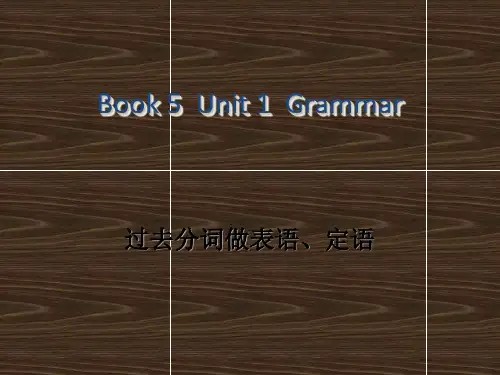
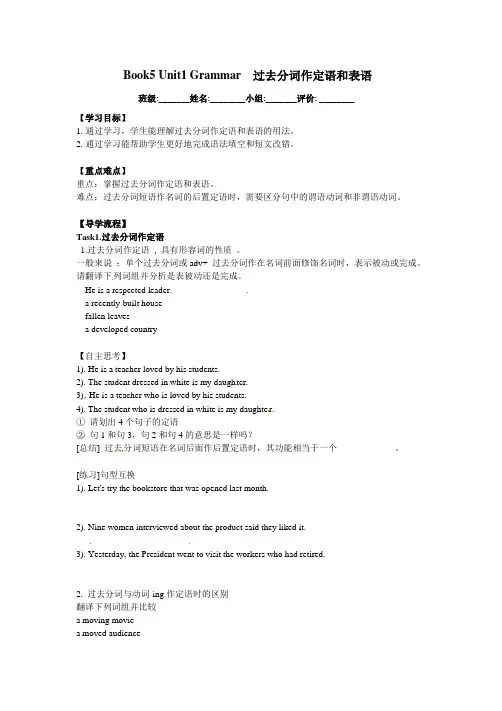
Book5 Unit1 Grammar 过去分词作定语和表语班级:_______姓名:________小组:_______评价: ________【学习目标】1.通过学习,学生能理解过去分词作定语和表语的用法。
2.通过学习能帮助学生更好地完成语法填空和短文改错。
【重点难点】重点:掌握过去分词作定语和表语。
难点:过去分词短语作名词的后置定语时,需要区分句中的谓语动词和非谓语动词。
【导学流程】Task1.过去分词作定语1.过去分词作定语, 具有形容词的性质。
一般来说:单个过去分词或adv+ 过去分词作在名词前面修饰名词时,表示被动或完成。
请翻译下列词组并分析是表被动还是完成。
He is a respected leader. _____________a recently-built house ____________fallen leaves ___________a developed country ____________【自主思考】1). He is a teacher loved by his students.2). The student dressed in white is my daughter.3). He is a teacher who is loved by his students.4). The student who is dressed in white is my daughte r.①请划出4个句子的定语②句1和句3,句2和句4的意思是一样吗?[总结] 过去分词短语在名词后面作后置定语时,其功能相当于一个_____________。
[练习]句型互换1). Let's try the bookstore that was opened last month.______________________________________________________________________________ _2). Nine women interviewed about the product said they liked it.______________________________________________________________________________ 3). Yesterday, the President went to visit the workers who had retired.______________________________________________________________________________2. 过去分词与动词-ing作定语时的区别翻译下列词组并比较a moving movie ______________a moved audience______________boiling water______________boiled water______________developing countries ______________developed countries ______________falling leaves ______________fallen leaves ______________[总结] 动词-ing作定语时与所修饰的名词之间是___________ (主/被)动关系,表示动作_____________ (进行/完成);过去分词作定语时,表示__________ (主/被)动关系或动作_____________ (进行/完成)。
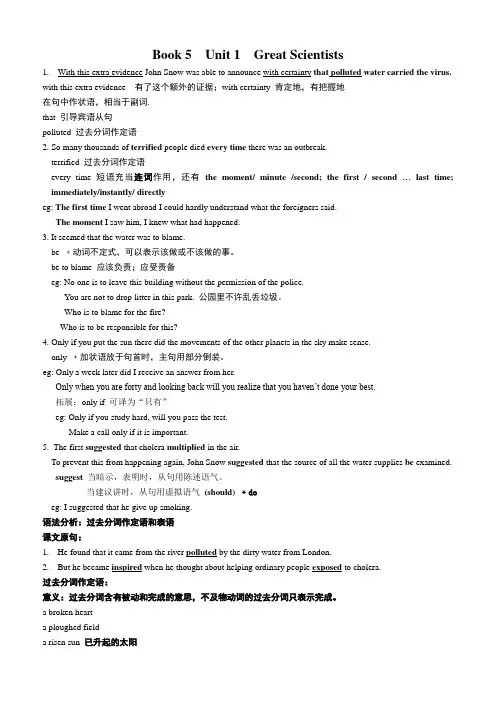
Book 5 Unit 1 Great Scientists1. With this extra evidence John Snow was able to announce with certainty that polluted water carried the virus. with this extra evidence 有了这个额外的证据;with certainty肯定地,有把握地在句中作状语,相当于副词.that 引导宾语从句polluted 过去分词作定语2. So many thousands of terrified people died every time there was an outbreak.terrified 过去分词作定语every time 短语充当连词作用,还有the moment/ minute /second; the first / second …last time; immediately/instantly/ directlyeg: The first time I went abroad I could hardly understand what the foreigners said.The moment I saw him, I knew what had happened.3. It seemed that the water was to blame.be﹢动词不定式,可以表示该做或不该做的事。
be to blame 应该负责;应受责备eg: No one is to leave this building without the permission of the police.Y ou are not to drop litter in this park. 公园里不许乱丢垃圾。
Who is to blame for the fire?Who is to be responsible for this?4. Only if you put the sun there did the movements of the other planets in the sky make sense.only ﹢加状语放于句首时,主句用部分倒装。
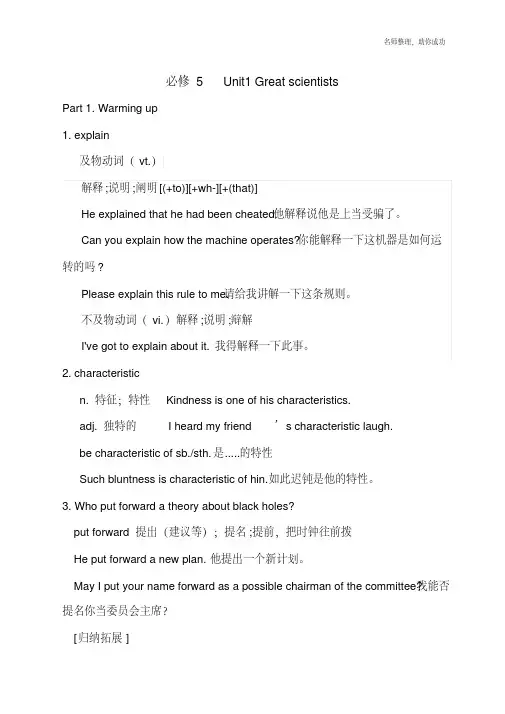
必修5 Unit1 Great scientistsPart 1. Warming up1.explain及物动词(vt.)解释;说明;阐明[(+to)][+wh-][+(that)]He explained that he had been cheated. 他解释说他是上当受骗了。
Can you explain how the machine operates?你能解释一下这机器是如何运转的吗?Please explain this rule to me.请给我讲解一下这条规则。
不及物动词(vi.)解释;说明;辩解I've got to explain about it. 我得解释一下此事。
2.characteristicn. 特征;特性Kindness is one of his characteristics.adj. 独特的I heard my friend’s characteristic laugh.be characteristic of sb./sth. 是.....的特性Such bluntness is characteristic of hin. 如此迟钝是他的特性。
3. Who put forward a theory about black holes?put forward 提出(建议等);提名;提前,把时钟往前拨He put forward a new plan. 他提出一个新计划。
May I put your name forward as a possible chairman of the committee?我能否提名你当委员会主席?[归纳拓展]put down 记下;镇压put out 关掉;熄灭put aside 放在一边;储存;保留put off 推迟;延期put up 建造;举起;张贴put on 穿上put away 收好Part 2. Pre-reading, reading and comprehending1. Do you know how to prove a new idea in scientific researchhow to prove a new idea 为“疑问词+不定式”结构,该结构可在句中作主语、宾语、表语等。
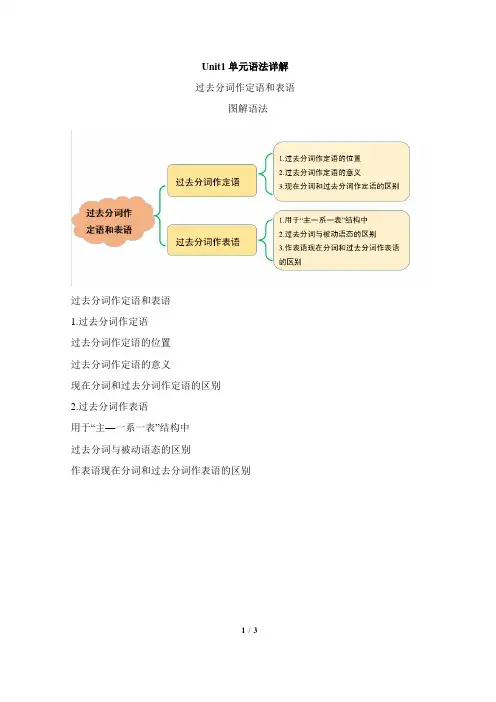
Unit1单元语法详解过去分词作定语和表语图解语法过去分词作定语和表语1.过去分词作定语过去分词作定语的位置过去分词作定语的意义现在分词和过去分词作定语的区别2.过去分词作表语用于“主—一系一表”结构中过去分词与被动语态的区别作表语现在分词和过去分词作表语的区别1/ 3归纳语法过去分词,也称动词的-ed形式,是一种非限定动词。
规则动词的-ed形式由动词原形词尾加-ed构成,也有不规则动词变化表。
动词的-ed形式只有一种形式,没有时态和语态的变化。
它在句子中可以充当定语、表语等成分。
一、过去分词作定语1.过去分词作定语时的意义过去分词作定语,强调被动或者完成。
The wind swept the fallen leaves.风刮走了落叶。
Her daughter brought up by me has begun to work.她由我带大的那个女儿已经开始工作了。
fallen leaves 落叶/falling leaves正在飘落的树叶2.过去分词作定语时的位置(1)单个的过去分词作定语,常放在所修饰的词的前面;过去分词短语作定语时,常放在所修饰的词之后,此时,它相当于定语从句。
He told me that this was the wounded soldier.他告诉我这就是那个受伤的士兵。
Don't use words, expressions or phrases known only to people with specific knowledge. 不要使用仅仅有特定知识的人才知晓的单词、词组或短语。
Near the window is a bookshelf filled with books (=which is filled with books).靠近窗户有一个装满书的书架。
2/ 3Most of the students invited to the garden party (=who were invited to the garden party)came from our school.大部分被邀请参加游园会的学生来自我们学校。
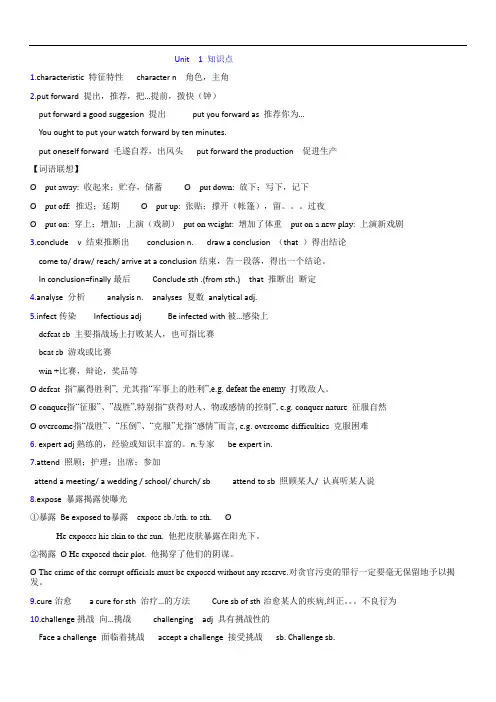
Unit 1 知识点1.characteristic 特征特性character n 角色,主角2.put forward 提出,推荐,把…提前,拨快(钟)put forward a good suggesion 提出put you forward as 推荐你为…You ought to put your watch forward by ten minutes.put oneself forward 毛遂自荐,出风头put forward the production 促进生产【词语联想】Ø put away: 收起来;贮存,储蓄Ø put down: 放下;写下,记下Ø put off: 推迟;延期Ø put up: 张贴;撑开(帐篷),留。
过夜Ø put on: 穿上;增加;上演(戏剧)put on weight: 增加了体重put on a new play: 上演新戏剧3.conclude v 结束推断出conclusion n. draw a conclusion (that )得出结论come to/ draw/ reach/ arrive at a conclusion结束,告一段落,得出一个结论。
In conclusion=finally最后Conclude sth .(from sth.) that 推断出断定4.analyse 分析analysis n. analyses 复数analytical adj.5.infect传染Infectious adj Be infected with被…感染上defeat sb 主要指战场上打败某人,也可指比赛beat sb 游戏或比赛win +比赛,辩论,奖品等Ø defeat 指“赢得胜利”, 尤其指“军事上的胜利”,e.g. defeat the enemy 打败敌人。
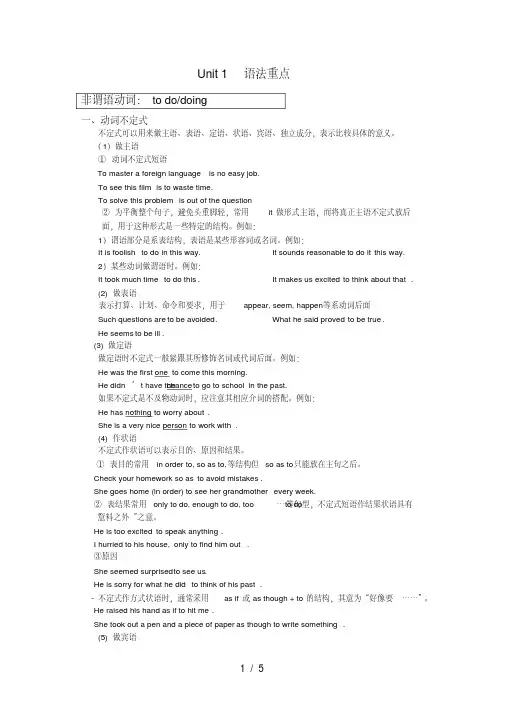
Unit 1 语法重点非谓语动词:to do/doing一、动词不定式不定式可以用来做主语、表语、定语、状语、宾语、独立成分,表示比较具体的意义。
(1)做主语①动词不定式短语To master a foreign language is no easy job.To see this film is to waste time.To solve this problem is out of the question②为平衡整个句子,避免头重脚轻,常用it做形式主语,而将真正主语不定式放后面,用于这种形式是一些特定的结构。
例如:1)谓语部分是系表结构,表语是某些形容词或名词。
例如:It is foolish to do in this way. It sounds reasonable to do it this way.2)某些动词做谓语时。
例如:It took much time to do this. It makes us excited to think about that.(2) 做表语表示打算、计划、命令和要求,用于appear, seem, happen等系动词后面Such questions are to be avoided. What he said proved to be true.He seems to be ill.(3) 做定语做定语时不定式一般紧跟其所修饰名词或代词后面。
例如:He was the first one to come this morning.chance to go to school in the past.He didn’t have the如果不定式是不及物动词时,应注意其相应介词的搭配。
例如:He has nothing to worry about.She is a very nice person to work with.(4) 作状语不定式作状语可以表示目的、原因和结果。
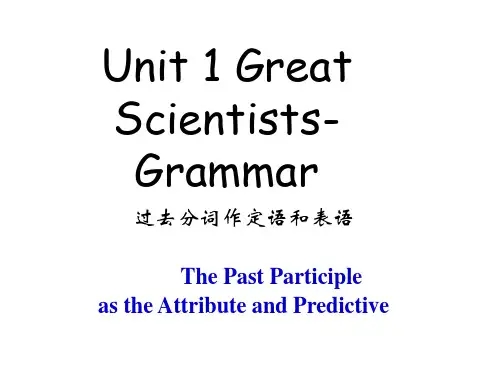
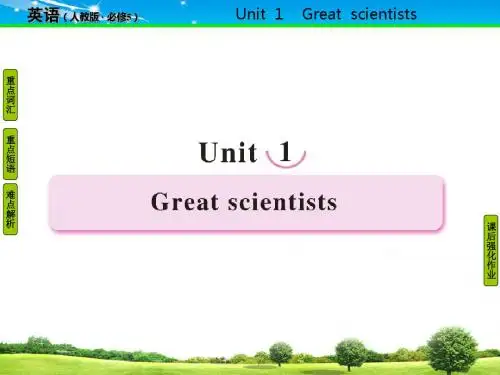
过去分词作定语1)语法功能过去分词或过去分词短语作定语时,其功能相当于一个定语从句。
被修饰的词是分词所表示的行为的承受者;在逻辑上,它们是动宾关系。
The stolen bike belongs to Jack. The bike which was stolen belongs to Jack.The lecture given by Professor Zhang is about environment protection.The lecture which was given by Professor Zhang is about the environment protection.a.单个的过去分词作定语时,位于它所修饰的名词或代词前面。
the affected people受感染的人 a broken heart一颗破碎的心a lost dog丧家之犬 a broken glass被打破的玻璃杯Attention:过去分词修饰 something, everything, anything, nothing, somebody, nobody,those 等不定代词时,要放在这些词后面。
Is there anything unsolved?There is noting changed here since I left this town.b. 过去分词短语作定语:通常后置,其作用相当于定语从句。
people exposed to cholera= people who was exposed to cholerathe book recommended by Jack= the book which was recommended by Jackthe machines produced last year= the machines which were produced last yearc. 不及物动词的过去分词作定语时不表被动,只表完成。
人教版高中英语必修5unit1知识讲解过去分词作表语和定语人教版高中英语必修5 unit1 过去分词作表语和定语概念引入今天我们要学习过去分词作表语和定语的用法。
先看下面这些句子:1. But he became inspired when he thought about helping ordinary people exposed to cholera.(inspired过去分词作表语;exposed过去分词作定语)2. So many thousands of terrified people died every time there was an outbreak.(terrified过去分词作定语)3. He became interested in two theories that possibly explained how cholera killed people.(interested 过去分词作表语)4. From the stomach the disease quickly attacked the body and soon the affected person died.(affected过去分词作定语)5. He was determined to find out why. (determined过去分词作表语)6. He found that it came from the river polluted by the dirty water from London.(polluted过去分词作定语)上面句子中的黑体词都是过去分词,句1(inspired)、句3、句5中的三个词跟在系动词became、was后作表语;而句1(exposed)、句2、句4、句6中的四个词放在名词前或后修饰名词,作定语。
那么过去分词是什么?有什么作用?我们将在本单元和下两个单元中与同学们一起学习。
必修5 Unit1 Great scientistsPart 1. Warming up1.explain及物动词(vt.)解释;说明;阐明[(+to)][+wh-][+(that)]He explained that he had been cheated. 他解释说他是上当受骗了。
Can you explain how the machine operates?你能解释一下这机器是如何运转的吗?Please explain this rule to me.请给我讲解一下这条规则。
不及物动词(vi.)解释;说明;辩解I've got to explain about it. 我得解释一下此事。
2.characteristicn. 特征;特性Kindness is one of his characteristics.adj. 独特的I heard my friend’s characteristic laugh.be characteristic of sb./sth. 是.....的特性Such bluntness is characteristic of hin. 如此迟钝是他的特性。
3. Who put forward a theory about black holes?put forward 提出(建议等);提名;提前,把时钟往前拨He put forward a new plan. 他提出一个新计划。
May I put your name forward as a possible chairman of the committee?我能否提名你当委员会主席?[归纳拓展]put down 记下;镇压put out 关掉;熄灭put aside 放在一边;储存;保留put off 推迟;延期put up 建造;举起;张贴put on 穿上put away 收好选词填空(put off, put up, put forward, put aside, put out)①The plan that you _____ at the meeting is wonderful.②Many tall buildings were _____ along the road.③Firefighters have been called to _____ the fire in the city center.④He has a little money to _____ for a rainy day.⑤Don’t _____ until tomorrow what can be done today.Part 2. Pre-reading, reading and comprehending1. Do you know how to prove a new idea in scientific researchhow to prove a new idea 为“疑问词+不定式”结构,该结构可在句中作主语、宾语、表语等。
必修5 Unit1 Great scientistsPart 1. Warming up1.explain及物动词(vt.)解释;说明;阐明[(+to)][+wh-][+(that)]He explained that he had been cheated. 他解释说他是上当受骗了。
Can you explain how the machine operates?你能解释一下这机器是如何运转的吗?Please explain this rule to me.请给我讲解一下这条规则。
不及物动词(vi.)解释;说明;辩解I've got to explain about it. 我得解释一下此事。
2.characteristicn. 特征;特性Kindness is one of his characteristics.adj. 独特的I heard my friend’s characteristic laugh.be characteristic of sb./sth. 是.....的特性Such bluntness is characteristic of hin. 如此迟钝是他的特性。
3. Who put forward a theory about black holes?put forward 提出(建议等);提名;提前,把时钟往前拨He put forward a new plan. 他提出一个新计划。
May I put your name forward as a possible chairman of the committee?我能否提名你当委员会主席?[归纳拓展]put down 记下;镇压put out 关掉;熄灭put aside 放在一边;储存;保留put off 推迟;延期put up 建造;举起;张贴put on 穿上put away 收好选词填空(put off, put up, put forward, put aside, put out)①The plan that you _____ at the meeting is wonderful.②Many tall buildings were _____ along the road.③Firefighters have been called to _____ the fire in the city center.④He has a little money to _____ for a rainy day.⑤Don’t _____ until tomorrow what can be done today.Part 2. Pre-reading, reading and comprehending1. Do you know how to prove a new idea in scientific researchhow to prove a new idea 为“疑问词+不定式”结构,该结构可在句中作主语、宾语、表语等。
高中英语必修五知识点汇总Unit1 Great Scientists1.help sb do sth 帮助某人做某事2.from…to…从…到…3.put forward sth = come up with sth 提出(观点、意见、方案等)4.draw a conclusion 得出结论5.face a challenge 面临挑战6.link…to…将…和…连接起来7.look into 调查8.so+adj/adv原级+that “如此…以至于”eg. She is so kind that everyone likes her.9.think about doing sth 考虑做某事think of sth想起某事10.expose to 暴露,显露11.遵循就近原则的几个短语:neither…nor…既不…也不…(两者都不)eg. Neither she and I am teacher.either…or…或者…或者…(两者选一)not only…but also…不仅…而且…not…but…不是前者而是后者12.thousands of 成千上万的three thousand三千注:hundred百, thousand千,million万等计数单位,若后面接of,则本身加s,否则无论几百几千都不加s13.at times 有时,偶尔14.sb be/get interested in doing sth 某人对做某事感兴趣15.absorb…into…将…吸收be absorbed in 专心于,全神贯注于16.be ready to do sth 准备做某事17.sb be determined to do sth 某人决定做某事18.find out找到find-found-found19.look into 调查come from来自20.sb be to blame for doing sth 因做某事某人应该受到惩罚=blame sb for doing sth21.It seems/seemed that…似乎…好像…seem to do sth 似乎做某事22.die of:死于内因(illness, cancer, a fever)die from:死于外因(an earthequake, a traffic accident, a stroke)23.instruct sb to do sth命令某人做某事24.announce sb to do sth 宣告某人做某事e to an end 结束,终结26.be+adj+to do stheg.Everybody was shocked to hear of the death of the famous film star.27.try to do sth企图做某事(已经付出行动)try doing sth 尝试做某事(只是想试一试,还没做)29. work on 从事于30.lead to doing sth 导致…(to在这里是介词)31.make sense有意义,讲得通make-made-made32.between…and……和…之间33.although “尽管,虽然”,引导让步状语从句,注意不能和but一起使用。
必修5 1 1.及物动词〔.〕解释;说明;说明[()][][+()]. 他解释说他是上当受骗了。
?你能解释一下这机器是如何运转的吗?.请给我讲解一下这条规那么。
不及物动词〔.〕解释;说明;辩白I' . 我得解释一下此事。
n. 特征;特性 .. 独特的I ’s .. 是.....的特性. 如此迟钝是他的特性。
3. a ?提出〔建议等〕;提名;提前,把时钟往前拨a . 他提出一个新方案。
I a ?我能否提名你当委员会主席?[归纳拓展]记下;镇压关掉;熄灭放在一边;储存;保存推迟;延期建造;举起;张贴穿上收好选词填空④ a a .⑤’t .2. ,1. aa 为“疑问词+不定式〞构造,该构造可在句中作主语、宾语、表语等。
’t . 我们还没有决定去哪里。
. 问题是什么时候动身。
2 a 得出结论1)作名词,意为“完毕,结论〞a 得出结论最后I a .最后,我对我的东京之行说几句。
2〕作动词,“完毕;断定;决定〞。
〔作插入语〕最后,作为总结(= ), I .3 a —, , . 约翰·斯诺是伦敦一位著名的医生——他确实医术精湛,以至于成了照料维多利亚女王的私人医生。
① n. 专家,能手〔心理学〕② .熟练的,有专门技术的需专门知识的工作. 参加,注意,照料① 参加a / / a② (): , , 伺候, 照顾,看护a 〔〕.③ 处理,注意倾听I – I .4. . 但当他一想到要帮助那些得了霍乱的普通人时,他就感到很振奋。
(1) 在句中是过去分词作后置定语,表示被动。
意为“患霍乱的〞。
如:. 鲁迅写的书是很受欢送的。
. 昨天我们看见的那个人是史密斯教授。
(2)①暴露 . 他把皮肤暴露在阳光下。
②揭露 . 他揭穿了他们的阴谋。
. 对贪官污吏的罪行一定要毫无保存地予以揭露。
. 暴露的,暴露于风雨中的,无掩蔽的n. 暴露,显露. 把某事暴露于光天化日之下a 揭穿骗局练习:, , .A. B. C. D.5 . 对于它的起因与治疗方法人们都不清楚。
Unit 1 语法重点一、动词不定式不定式可以用来做主语、表语、定语、状语、宾语、独立成分,表示比较具体的意义。
(1)做主语①动词不定式短语To master a foreign language is no easy job.To see this film is to waste time.To solve this problem is out of the question②为平衡整个句子,避免头重脚轻,常用it做形式主语,而将真正主语不定式放后面,用于这种形式是一些特定的结构。
例如:1)谓语部分是系表结构,表语是某些形容词或名词。
例如:It is foolish to do in this way. It sounds reasonable to do it this way.2)某些动词做谓语时。
例如:It took much time to do this. It makes us excited to think about that.(2) 做表语表示打算、计划、命令和要求,用于appear, seem, happen等系动词后面Such questions are to be avoided. What he said proved to be true.He seems to be ill.(3) 做定语做定语时不定式一般紧跟其所修饰名词或代词后面。
例如:He was the first one to come this morning.He didn’t have the chance to go to school in the past.如果不定式是不及物动词时,应注意其相应介词的搭配。
例如:He has nothing to worry about.She is a very nice person to work with.(4) 作状语不定式作状语可以表示目的、原因和结果。
①表目的常用in order to, so as to,等结构但so as to只能放在主句之后。
Check your homework so as to avoid mistakes.She goes home (in order) to see her grandmother every week.②表结果常用only to do, enough to do, too…to do等句型,不定式短语作结果状语具有“意料之外”之意。
He is too excited to speak anything.I hurried to his house, only to find him out.③原因She seemed surprised to see us.He is sorry for what he did to think of his past.-不定式作方式状语时,通常采用as if 或 as though + to 的结构,其意为“好像要……”。
He raised his hand as if to hit me.She took out a pen and a piece of paper as though to write something.(5) 做宾语①某些及物动词要用动词不定式作宾语, 以下及物动词常用动词不定式作宾语:agree, ask, attempt, choose, continue, decide, desire, determine, expect, forget,hope,,intend, learn, manage, mean, offer, prefer,,promise, refuse, try,want, wish等。
例如:②动词不定式作宾语时,如其后有补足语,则可以用先行语it作形式宾语,而将真正宾语动词不定式后移,用于该形式的常见动词有:believe, consider, feel, guess, imagine, know, make, prove, realize, see, show, suppose, think, understand, find等。
例如:I felt it useless for us to say anything further.I made it a rule to get up early, take a cold bath, and then do some running.(6) 做宾语补足语①带to的不定式做宾补有相当数量的及物动词或短语可以接带to的不定式做宾补。
例如:I shall try to persuade her to see the doctor. The villagers didn’t allow them to do this.I will ask them to leave the company. I shall persuade him to take the medicine.②不带to的不定式做宾补也有一些及物动词后接不带to的不定式作宾补,常见的有使役动词类:make, let, have;感官动词类:see, watch, look at, notice, observe, hear, listen to, smell, feel等。
但在被动结构中要带to (let除外)。
例如:Someone saw him enter my room. He was seen to enter my room.The boy made the baby laugh. The baby was made to laugh(7)“疑问词+不定式”相当于这些疑问代词和副词引导的名词性从句。
常见引导该形式的动词有:decide, find out, forget, inquire, know, learn, remember, see, settle, think, 在句子中可以做主语、宾语或表语。
例如:What to do next has not been decided. = What will do next has not been decided.What worries me most is how to do it. = What worries me most is how we will do it.I don’t know when to leave. = I don’t know when we will leave.(10) 动词不定式的复合结构①不定式的复合结构做主语时,常见用两种特定句型: “It is + adj. for / of sb. to do sth.”和“It is + n. of sb. to do sth”。
例:It is easy for us to understand the sentence.It is clever of you to do that.二、动名词动名词是一种非谓语形式,起名词的作用,但带有动词的特征,可以有自己的宾语和状语,构成动名词短语。
1.动名词的用法(1) 做主语①动名词做主语表示比较抽象、习惯性和经常性的意义.例如:Saying is easier than doing. Collecting stamps is a good hobby.②为平衡整个句子,避免头重脚轻,常用it做形式主语,而将真正主语不定式放后面,用于这种形式是一些特定的结构。
例如:1) 谓语部分是系表结构,表语是某些形容词。
例如:It’s interesting planning a holiday. It’s rather tiring walking around in a city.2) 当use,good,waste,bore,fun,shame,encouragement,等名词作表语时,通常用it作形式主语,把作为真正主语的动名词后置。
例如:It’s no use talking to him again. = There is no use talking to him again.It’s no good refusing to do it. = There is no good refusing to do it.(2) 作宾语某些动词或短语动词后面可以接动名词,见下表:①放在介词on; upon,after等后面时,例如:On arriving Beijing, he went to see his friend.After standing in the queue for hours, we got good seats.③有些后面可跟动名词也可以跟不定式,意义区别不大。
常见的动词有:s tart, like, hate, love, continue, prefer, attempt, intend, propose等。
He began learning (to learn) English at the age of five.④有些动词后面可跟动名词也可以跟不定式,意义区别大。
见下表:(3) 作表语相当于名词,说明主语动作的情况和状态。
例如:My job is teaching English.Her job is taking care of the children.Our duty is serving the people. = Our duty is to serve the people.(4) 作定语说明所修饰词的性质,具有名词的性质,它同所修饰的名词间不存在主谓关系。
a living room = a room for living a swimming pool = a pool for swimminga waling stick = a stick for walking(5) 动名词的复合结构动名词之前的名词,如果是有生命的,通常用所属格表示,如果是无生命的,则用通格表示,现在有一种趋势用名词和代词代替所有格。
His coming won’t help much.I don’t mind your (you) smoking.They insisted on our staying there. We are happy about his coming to see us.Do you remember Mary coming to see you? He insisted on being sent to the hard area.(6) 动名词的主动形式表示被动意义① be worth 后接动名词时。